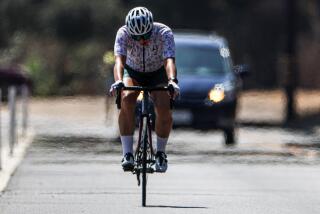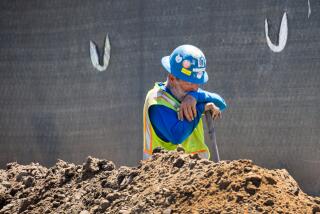Chill Settles in Homes as Cost of Power Soars
The floor furnace in Shirley Reynolds’ Venice home broke three years ago and she has yet to get it fixed. On a cold winter day, Reynolds heats her house by baking dinner. Later, she’ll throw an extra blanket on the bed.
Norm Petersen, 75, spent New Year’s Day swimming in chilly San Francisco Bay. Having inured himself to the cold by swimming in the bay three or four times a week as the water temperature slid to barely 50 degrees since summer, Petersen turns on the heater in his Marin County home only when his wife complains.
“People in our generation are coddled,” said Stephen Harris, a North Hollywood personal trainer who believes cold air is healthful. “The Spartans exposed themselves to the elements to make themselves hardier.”
Besides, spending money on heat is a waste if you can just as easily put on a sweatshirt, Harris said.
Heat is an absolute necessity on the East Coast, where freezing temperatures, oil-fired boilers and steam radiators leave people with parched skin and winter blues. But Southern California’s Mediterranean climate is a different case.
Even on cold nights, the temperature in an unheated house here seldom poses a risk of hypothermia. The heat required to stay toasty in Minneapolis, the most frigid big city in America, is more than five times what’s needed in Los Angeles.
Nonetheless, people are starting to think twice before hitting the home thermostat switch as the cost of home heating soars with rising power bills. A shortage has quadrupled the price of natural gas over the last year.
The average monthly winter gas bill for a Southern California Gas Co. residential customer will hit $80 this year, up from $50 last winter, according to the utility.
Natural gas heats almost 70% of California homes, according to the federal Energy Information Administration. The 25% of Californians who heat with electricity also will take a hit as those rates move up.
For some, rising power rates have created financial choices more difficult than whether to reach for the heater switch or put on a sweater.
The electricity bill for Nora Whitcotton of El Cajon now averages at least twice what it was a year ago, reaching almost $85 in November. In some months it’s three times as much. Whitcotton, a 63-year-old with a lung ailment, has to pay to run her oxygen machine 24 hours a day.
“Older people learn to cut corners when they are on a budget, but there is no such thing as a coupon for electricity,” Whitcotton said.
Fortunately, this winter has been warm enough so far to get by with extra blankets on the bed and warm sweatpants, Whitcotton said. That way, she can save her electricity budget for air conditioning in the summer, when the hot air carries less oxygen.
The power companies, cognizant of such tough choices, offer some discounts to low-income customers.
The CARE program offered by San Diego Gas & Electric and Southern California Gas gives some disabled and low-income customers--including Whitcotton--a 15% discount on natural gas and electricity bills.
The number of people signing up for the programs has increased significantly as energy prices have risen. In September, 146,318 SDG&E; customers received the discount--about 20,000 more than a year earlier. Southern California Gas has seen its enrollment jump by almost 26,000, to 548,242 in November from a year earlier.
Few Manage With No Heat at All
Even though people can live with lower temperatures, few go to the extreme of using no heat.
Power prices typically have to about double before consumers start changing their habits by living colder in the winter and hotter in the summer, said Willett Kempton, a professor at the University of Delaware’s Center for Energy and Environmental Policy.
Georgia Thompson, a 57-year-old horse rancher in northern San Diego County, decided to live with less heat after she received a $700 electricity bill in September. Much of the bill reflected the cost of operating a pump to water five acres of pasture for her 10 horses.
The dry fall and winter have made the pump a necessity, leaving Thompson to skimp on heat instead, even though nighttime temperatures in her tiny town of Bonsall often dip into the low 30s.
“At night we wait until we get real cold and then we jump into bed,” Thompson said. “Even our cat climbs under the covers.”
There’s some evidence that residents of colder climes put up with lower temperatures in their homes more readily than residents of warmer regions, perhaps looking to trim fuel bills.
Just 7.2% of New England residents heat their homes to 74 degrees or more on winter days, according to a 1997 survey by the Energy Information Administration. But more Californians do: 11.2%, according to the study. And Floridians really like it hot, with nearly a third heating their homes that much.
“You could attribute that to the classic stereotype of New England frugality, but it could just as easily be other reasons,” said Kempton.
He said New England homes are likely to be built with better insulation and fewer drafts than California homes, factors that allow their inhabitants to feel relatively warmer at cooler temperatures.
Cultural differences, rather than climate, more often account for how warm people keep their homes, said Kempton, who has his thermostat set at 62 degrees. One study, he said, found that Swedes kept their homes warmer than the British, even though Swedish winters are much colder than those in England.
Throughout most of Southern California, there’s not much of a health threat in turning down the thermostat or even turning off the heater on all but the coldest of nights, said Alicia McDonough, a physiology professor at USC’s Keck School of Medicine.
“This isn’t Minnesota,” McDonough said. “You are not going to get hypothermia walking around in your home. It provides too much insulation to get that cold.”
Indeed, one measure of heat requirements--so called heating degree days--shows how warm it is in Southern California. To calculate the heating degree days for a particular day, subtract the day’s average temperature from 65 degrees. Thus, a day on which the average temperature was 60--a daily high of 70 and low of 50, for example--would have five heating degree days.
Los Angeles has an annual average of 1,458 heating degree days, according to the National Weather Service. Minneapolis averages 7,981. A Twin Cities resident uses more heat in January than an Angelino uses all year.
While there is some truth to the view that physical changes within people’s bodies can help condition them to cold, those changes are much more complicated than the so-called “thickening of the blood” that cold weather fans like to talk about.
“What does happen is that the vessels carrying blood to the capillaries in the outside layer of your skin learn to constrict more quickly,” McDonough said.
That prevents people from losing warmth by keeping warm blood farther from the heat-dissipating surface of the skin. It also increases the blood volume in the core of the body. That triggers a loss of fluids, which does create denser blood temporarily, McDonough said. In rare cases, it might present a danger of a stroke.
Harris, the personal trainer, said he laughs when Southern Californians complain about cold weather. “I am a Colorado native, and my aunts still talk about going outside in the winter to use the outhouse,” he said. “What’s considered cold here isn’t.”
More to Read
Inside the business of entertainment
The Wide Shot brings you news, analysis and insights on everything from streaming wars to production — and what it all means for the future.
You may occasionally receive promotional content from the Los Angeles Times.










